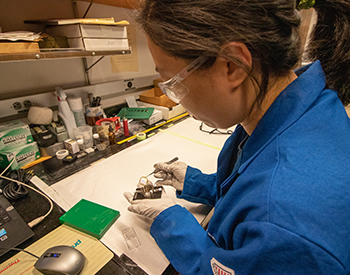UC San Diego Strikes New NSF Funding with Laser Speed
Chemist Wei Xiong receives nearly $600K to investigate polaritons with ultrafast lasers while diversifying science
December 14, 2018 | By Cynthia Dillon

With a deftness in chemistry like the skill of a Jedi with a lightsaber, the University of California San Diego’s experimental physical chemist Wei Xiong is challenging the basic properties of polaritons. These are hybrid particles resulting from the interaction of electromagnetic wavelengths and molecular or material excitations—states of elevated energy caused, in this case, by photons. The unique properties of polaritons could be useful to society in several ways—from medicine and chemical sensing to homeland security and seeing in the dark. But more must be learned about polariton interactions, and more must be done to include underrepresented minorities (URMs) in the science. Such is the mission of Xiong as deemed by the National Science Foundation.
With an NSF Faculty Early Career Development Program (CAREER) award project titled, “Coherences and Nonlinear Interactions in Molecular Infrared Polaritons,” Xiong and his team of researchers will use ultrafast lasers to study, over five years, the fundamental properties of polaritons in the mid-infrared regime of the electromagnetic spectrum and aim to understand and control interactions among them. The results of this fundamental research are expected to contribute to the eventual development of new technological capabilities in chemical sensing, materials development and visualization in the dark.

“The scientific aim of this project is to understand and control the coherences and nonlinear interactions of multiple molecular infrared polaritons, 'on a chip',” explained Xiong. “The outcome would enable mid-infrared photonic devices, such as mid-infrared optical modulators, waveguides and lasers that are crucial for realizing lab-on-chip, mid-infrared chemical sensing for the medical and material industries.”
According to Xiong, the properties and applications of polaritons resulting from molecule-light interactions for some wavelengths of light have been investigated, but relatively little is known about polaritons associated with light at wavelengths in the mid-infrared part of the electromagnetic spectrum.
Another important component of the project is the development of an online course in photonic materials research aimed at first- and second-year undergraduate students. The course is designed to help overcome many students' fears about math- and science-centric topics and to attract a more diverse group of students to the field of materials research. In fact, the project establishes a pipeline for engaging URM students in summer research activities at UC San Diego through collaboration with faculty members at historically black colleges and universities.
To advance basic knowledge of mid-infrared polaritons, the research team plans to work on two important aspects: (1) breaking the coherence limits that currently constrain the use of mid-infrared photons for photonic circuitry and molecular sensing, and (2) opening the gateway for creating coherent superpositions of multiple coupled quantum states for multi-color photonic devices via chip. Additionally, the novel ultrafast mid-infrared spectroscopic imaging to be developed can be extended into other mid-infrared photonic studies.
This project is fully supported by the National Science Foundation (award no. 1848215).
At UC San Diego, we prefer the path less traveled. And it has led us to remarkable new ways of seeing and making a difference in the world.
